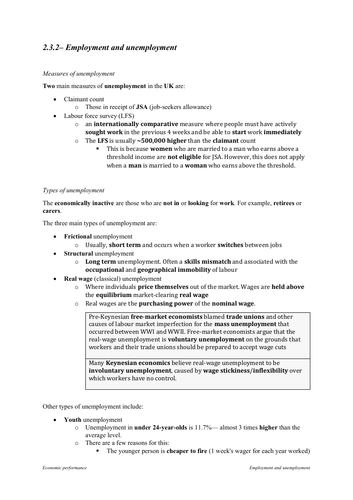4Uploads
110Views
5Downloads
All resources

1.2.1– Consumer Behaviour
A* AQA A/AS-Level Economics notes on consumer behaviour, covering the first topic in individual economic decision making. Includes key terms, diagrams, context, and explanation covering all specification points for this topic. (Specifications 7135 & 7136)
Includes:
• Rational economic decision making and economic incentives.
• Utility theory: total and marginal utility, and the hypothesis of diminishing marginal utility.
• Utility maximisation.
• The importance of the margin when making choices.

1.2.2– Imperfect Information
A* AQA A/AS-Level Economics notes on imperfect information covering the second topic in individual economic decision making. Includes key terms, causes, analysis, and the evaluation of policies to reduce market failure covering all specification points for this topic.
(Specifications 7135 & 7136)
Includes:
The importance of information for decision making.
The significance of asymmetric information.
Policies to correct information failure

1.2.3/4– Behavioural Economic Theory & Policy
A* AQA A/AS-Level Economics notes on behavioural economic theory and policy, covering the third and fourth topic in individual economic decision making. Includes key terms, context, evaluation, and explanation covering all specification points for this topic.
(Specifications 7135 & 7136)
Includes:
Bounded rationality and bounded self-control.
Biases in decision making: rules of thumb, anchoring, availability and social norms.
The importance of altruism and perceptions of fairness.
Choice architecture and framing.
Nudges.
Default choices, restricted choice and mandated choice.
Government policy and application of behavioural economic theory

2.3.2– Employment & Unemployment
A* AQA A/AS Level Economics notes on employment and unemployment, with explanations, analysis, and evaluation to achieve top marks. Macroeconomic notes with an explanation of varying economic schools of thought.
Includes:
• The main UK measures of unemployment, ie the claimant count and the Labour Force Survey measure.
• The concepts of voluntary and involuntary unemployment.
• The terms seasonal, frictional, structural and cyclical unemployment.
• How employment and unemployment may be determined by both demand-side and supply-side factors.
• The concept of, and the factors which determine, real wage unemployment.
• The concept of, and the factors which determine, the natural rate of unemployment.
• The consequences of unemployment for individuals and for the performance of the economy.




